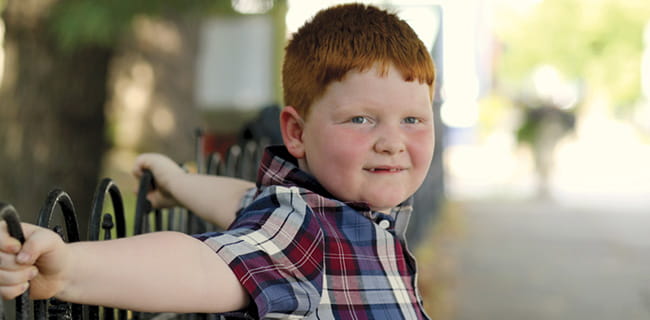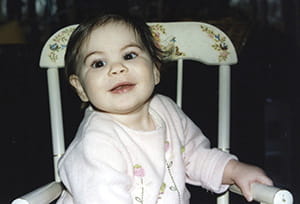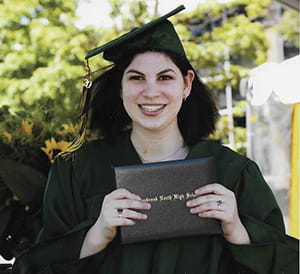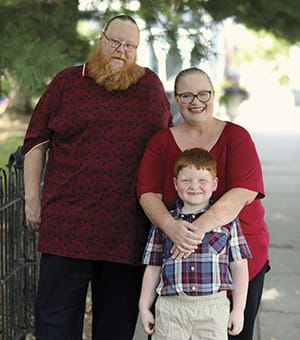Compassionate Care in the Most Critical Moments
“I was there. I saw it happen. I was just a few feet away, helpless, as the car hit Logan.”
Niki was hysterical as she rushed to her son’s side. He was bleeding, and she and her husband Jason feared for the worst. Did Logan hit his head? Did he have internal injuries or broken bones?
Logan was rushed to the closest hospital and placed in a waiting room full of adults. Niki’s unease grew when a nurse came to ask him questions using words her terrified 6-year-old didn’t understand.
As any parent or caregiver would, Niki and Jason advocated for their son and decided they wanted him to have specialized, child-centered care, so they transferred him to the Emergency Department (ED) at Cincinnati Children’s.
“The minute we walked in the doors,” Niki says, “I knew Logan was in the right hands.”
Our Front Door to the Community
Our ED is one of the busiest in the nation. Last year, we had nearly 120,000 visits, treating children and teens with a broad range of illnesses and injuries—from simple medical emergencies like broken bones, to complex trauma cases like car accidents and brain injuries, to the ever-increasing number of kids experiencing a mental health crisis.
That’s why this important service of the medical center was a point of focus as we developed the plan for our new Critical Care Building (CCB). The new space is nearly three times larger than our original ED and will improve and enhance how we provide care.
With dedicated space for medical, surgical, on-site imaging, trauma and mental health care, the new ED provides the infrastructure for best-in-class care in a state-of-the-art facility—allowing us to meet the needs of every family who comes to our door.
And since the world-class care at Cincinnati Children’s is driven by our world-renowned research, our Emergency Department is the first of its kind in the country with embedded research space. It includes wet and dry labs, education and conference facilities, as well as clinical trial space—setting us apart from all other pediatric medical centers.
As soon as Niki and Jason arrived at Cincinnati Children’s with their son, their fears began to wane. “Within 3 minutes, Logan was in the trauma bay, surrounded by doctors and nurses,” Niki remembers. “They were caring and reassuring—they left me feeling so much calmer than when I arrived. And the entire team worked like a well-oiled machine.”
Best Care, Best Experience
Our new ED is more than just fresh new spaces. Every inch was designed by a collaborative team of architects, medical staff and patient-families to ensure that we’re equipped to provide both the most innovative emergency medical care and the best possible experience for our patients and their loved ones.
When Every Second Counts
As the only Level 1 Pediatric Trauma Center in more than a 100-mile radius, we receive patients from all over the region. Every second matters in these critical life-and-death situations, and they often require the expertise of up to 15 care providers at a time.
The size, scope and functional attributes of the new trauma bay are optimized for this complex care. In addition to direct access to the operating rooms and Pediatric Intensive Care Unit, there’s a fully equipped radiology lab located just 10 feet from the bay, so critically ill patients don’t have to be transported to other areas of the hospital for X-rays and other diagnostic testing.
Answering the Call
Children and adolescents are struggling with unprecedented levels of depression, anxiety, mood disorders, post-traumatic stress disorder and other conditions. And experts agree the ongoing stress of the COVID-19 pandemic will further impact the mental health and well-being of children and teens.
Each day, 15–35 families come through our doors seeking help and hope for a child or teen experiencing a mental health emergency. The new ED has an area devoted to their care and will be equipped to ensure their safety.
Caring for the Care Team
Our clinicians become invested in each child under their care. It’s important for them to have space to regroup and catch their breath when facing a challenging day. The new ED offers respite space for staff to step away from the floor for a few minutes to rejuvenate and gear back up to face the life-and-death situations they see every single day.
The Science of Everyday Care
Our Emergency Medicine program is internationally recognized for our innovation—which is why we’re a leading recipient of pediatric National Institutes of Health funding. In fact, many of today’s best practices, including head trauma and CT scan protocols, were established right here at Cincinnati Children’s.
Going Above and Beyond for Our Families
Thankfully, Logan came away from the accident with just some bumps and bruises. These days, the fiery first grader is very careful to cross the street with his parents and is back to racing his remote control cars and loving school.
Niki and Jason will never forget the compassionate, above-and-beyond care their family received when they needed us most.
“Even though that might have been a typical Friday night for the experts at Cincinnati Children’s,” Niki starts, catching her breath for a moment, “they understood that for us, it was the scariest night of our lives. They treated us like Logan was their only patient, and I bet all those other worried parents felt the same.”
We couldn’t agree more. Our new CCB aligns our facility with the caliber of care we provide—and the experience our patient families deserve.
For more information or to make a gift, please contact Lauren Bosse at 513-803-0639 or lauren.bosse@cchmc.org.







